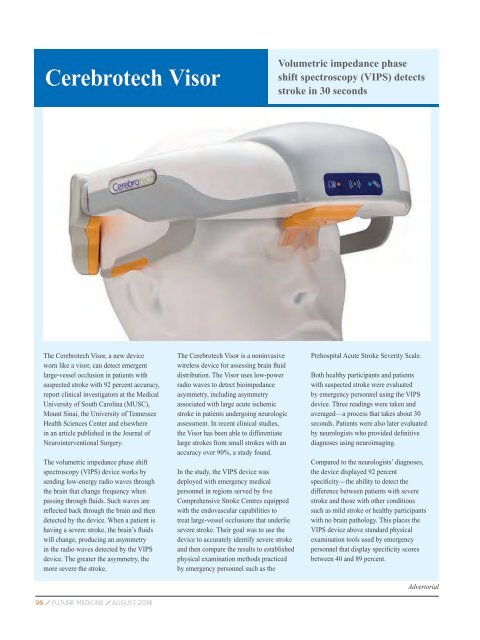FM AUGUST 2018 ISSUE1 - digital edition
Create successful ePaper yourself
Turn your PDF publications into a flip-book with our unique Google optimized e-Paper software.
Cerebrotech Visor<br />
Volumetric impedance phase<br />
shift spectroscopy (VIPS) detects<br />
stroke in 30 seconds<br />
The Cerebrotech Visor, a new device<br />
worn like a visor, can detect emergent<br />
large-vessel occlusion in patients with<br />
suspected stroke with 92 percent accuracy,<br />
report clinical investigators at the Medical<br />
University of South Carolina (MUSC),<br />
Mount Sinai, the University of Tennessee<br />
Health Sciences Center and elsewhere<br />
in an article published in the Journal of<br />
Neurointerventional Surgery.<br />
The volumetric impedance phase shift<br />
spectroscopy (VIPS) device works by<br />
sending low-energy radio waves through<br />
the brain that change frequency when<br />
passing through fluids. Such waves are<br />
reflected back through the brain and then<br />
detected by the device. When a patient is<br />
having a severe stroke, the brain’s fluids<br />
will change, producing an asymmetry<br />
in the radio waves detected by the VIPS<br />
device. The greater the asymmetry, the<br />
more severe the stroke.<br />
96 / FUTURE MEDICINE / <strong>AUGUST</strong> <strong>2018</strong><br />
The Cerebrotech Visor is a noninvasive<br />
wireless device for assessing brain fluid<br />
distribution. The Visor uses low-power<br />
radio waves to detect bioimpedance<br />
asymmetry, including asymmetry<br />
associated with large acute ischemic<br />
stroke in patients undergoing neurologic<br />
assessment. In recent clinical studies,<br />
the Visor has been able to differentiate<br />
large strokes from small strokes with an<br />
accuracy over 90%, a study found.<br />
In the study, the VIPS device was<br />
deployed with emergency medical<br />
personnel in regions served by five<br />
Comprehensive Stroke Centres equipped<br />
with the endovascular capabilities to<br />
treat large-vessel occlusions that underlie<br />
severe stroke. Their goal was to use the<br />
device to accurately identify severe stroke<br />
and then compare the results to established<br />
physical examination methods practiced<br />
by emergency personnel such as the<br />
Prehospital Acute Stroke Severity Scale.<br />
Both healthy participants and patients<br />
with suspected stroke were evaluated<br />
by emergency personnel using the VIPS<br />
device. Three readings were taken and<br />
averaged—a process that takes about 30<br />
seconds. Patients were also later evaluated<br />
by neurologists who provided definitive<br />
diagnoses using neuroimaging.<br />
Compared to the neurologists’ diagnoses,<br />
the device displayed 92 percent<br />
specificity—the ability to detect the<br />
difference between patients with severe<br />
stroke and those with other conditions<br />
such as mild stroke or healthy participants<br />
with no brain pathology. This places the<br />
VIPS device above standard physical<br />
examination tools used by emergency<br />
personnel that display specificity scores<br />
between 40 and 89 percent.<br />
Advertorial


















